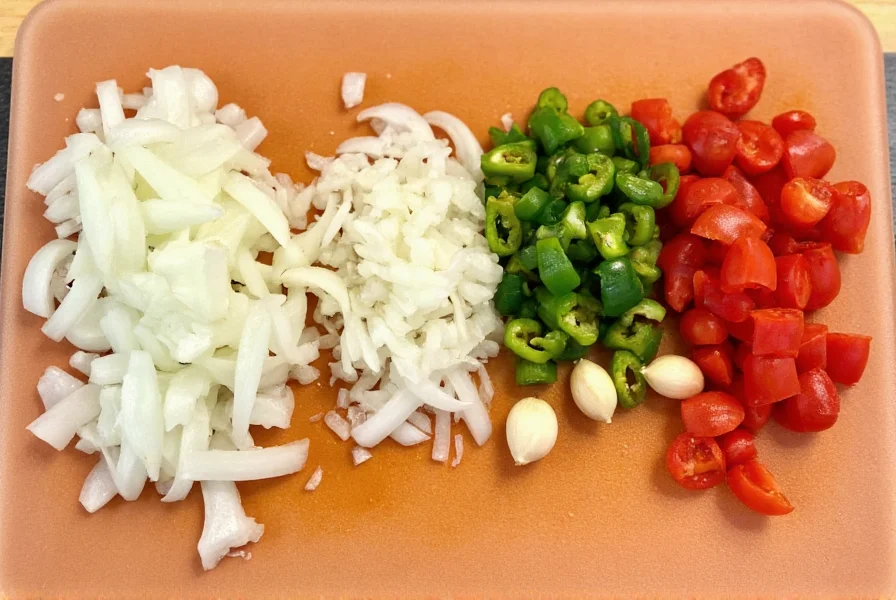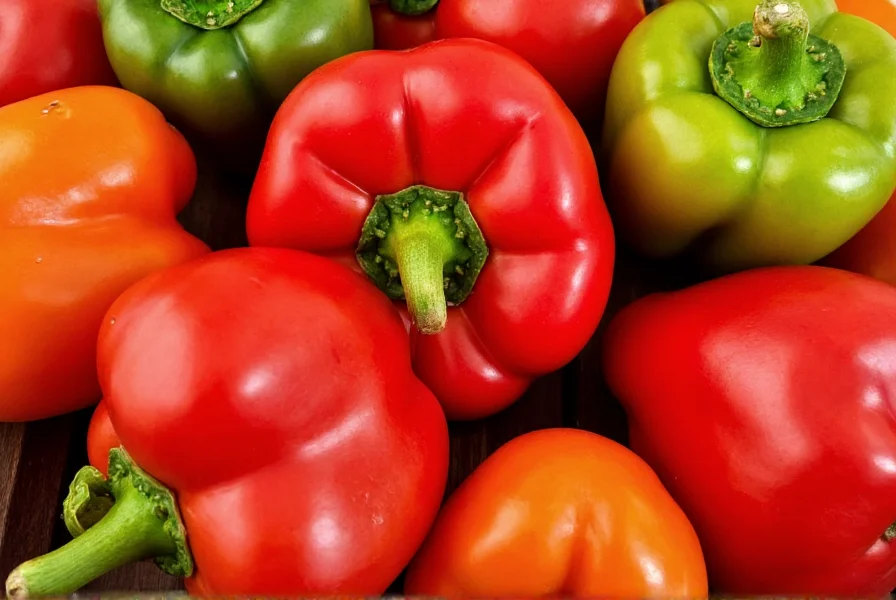Chili stands as one of America's most beloved comfort foods, and incorporating the right vegetables transforms this hearty dish from ordinary to extraordinary. Whether you're crafting a traditional meat-based chili or exploring vegetarian alternatives, understanding vegetable selection and preparation makes all the difference in achieving that perfect balance of flavor, texture, and nutrition.
Essential Flavor Base Vegetables
Every exceptional chili begins with a solid flavor foundation. These vegetables form the "holy trinity" that builds depth and complexity:
- Onions - Yellow onions provide the essential sweetness that balances chili's heat. For best results, sauté until translucent before adding other ingredients.
- Bell peppers - Green peppers offer earthiness, while red and yellow varieties add natural sweetness. Roasting them first enhances their flavor profile for chili.
- Garlic - Fresh garlic cloves, minced and added after onions, create aromatic complexity. Avoid pre-minced varieties for superior taste.
Professional chefs recommend sweating these vegetables slowly over medium heat rather than rushing the process. This technique, called sweating, draws out natural sugars without browning, creating a flavor base that supports rather than competes with chili spices.
Vegetables That Add Substance and Texture
When considering vegetables for chili that provide heartiness without meat, these options deliver satisfying texture and nutrition:
| Vegetable | Preparation Tip | Flavor Contribution |
|---|---|---|
| Mushrooms | Slice thickly and sear before adding | Umami richness that mimics meat |
| Eggplant | Cube and roast before incorporating | Meaty texture that absorbs spices |
| Zucchini | Add in last 15 minutes of cooking | Fresh vegetal note without mushiness |
| Sweet potatoes | Dice small and pre-roast | Natural sweetness balancing heat |
For authentic vegetarian chili recipes, mushrooms deserve special attention. Cremini or portobello varieties, when properly prepared, deliver a meaty texture that satisfies even carnivores. The key lies in removing excess moisture through searing before adding to the chili pot.
Beans and Legumes: Protein Powerhouses
When exploring vegetables for chili that provide protein, beans and lentils become essential components. While technically legumes, they function as vegetable components in chili preparation:
- Black beans - Hold their shape well and provide earthy flavor
- Kidney beans - Traditional choice with meaty texture
- Pinto beans - Creamy texture that thickens chili naturally
- Lentils - Brown or green lentils maintain texture better than red varieties
Proper bean preparation makes a significant difference. If using canned beans, rinse thoroughly to remove excess sodium and the starchy liquid that can make chili slimy. For dried beans, soaking overnight reduces cooking time and improves digestibility.
Vegetables That Enhance Flavor Complexity
Beyond the basics, certain vegetables elevate chili from good to exceptional through nuanced flavor contributions:
- Tomatoes - Canned fire-roasted tomatoes add smoky depth that fresh tomatoes can't match
- Corn - Fresh or frozen kernels added near the end provide sweet contrast
- Carrots - Finely grated and cooked into the base, they add subtle sweetness
- Beets - Small amounts contribute earthiness and vibrant color
One professional technique worth noting: adding a small amount of dark chocolate or espresso powder enhances the natural flavors of these vegetables without making the chili taste like either ingredient. This works particularly well with tomato-based vegetable chili recipes.

Vegetables to Use Sparingly or Avoid
Not all vegetables work well in chili. Some disrupt the flavor balance or create undesirable textures:
- Broccoli and cauliflower - Their strong flavors compete with chili spices
- Leafy greens - Add at the very end if desired, but they don't contribute to the base flavor
- Cucumber - High water content makes chili watery
- Raw potatoes - Must be pre-cooked or they'll remain hard
Understanding which vegetables work well in chili prevents common mistakes that dilute flavor. The goal is creating harmony between ingredients, not simply adding vegetables for the sake of health.
Special Considerations for Vegetarian Chili
When preparing meatless chili, vegetable selection becomes even more critical for achieving satisfying results. The best vegetables for vegetarian chili include:
- Multiple bean varieties - Combining 2-3 types creates complex texture
- Mushroom varieties - Mixing cremini with shiitake adds depth
- Roasted root vegetables - Sweet potatoes and beets add natural sweetness
- Textured vegetable protein (TVP) - Rehydrated with vegetable broth
For optimal results with healthy vegetable chili recipes, consider the "layering" technique: add different vegetables at various cooking stages to preserve their individual characteristics while allowing flavors to meld.
Preparation Techniques That Make a Difference
How you prepare vegetables for chili matters as much as which ones you choose:
- Dry roasting - Cook peppers and onions in the pot without oil first to develop caramelization
- Char-grilling - Especially effective for tomatoes and peppers before chopping
- Sweating - Slow cooking onions and garlic in minimal oil to draw out sweetness
- Finishing touches - Add delicate vegetables like zucchini in the last 15 minutes
These techniques maximize flavor development in vegetable-based chili recipes. The extra time invested in proper vegetable preparation pays dividends in the final dish's complexity and depth.
Storage and Reheating Tips
Vegetable chili often tastes better the next day as flavors continue to meld. For best results:
- Cool completely before refrigerating
- Store in airtight containers for up to 5 days
- Freeze in portion-sized containers for up to 3 months
- Reheat gently on stove with a splash of broth if needed
When reheating, consider adding fresh herbs or a squeeze of lime to brighten flavors that may have mellowed during storage. This technique works particularly well with vegetable combinations for chili that include tomatoes and beans.
Frequently Asked Questions
Can I make chili without onions and garlic?
Yes, though you'll miss foundational flavors. Substitute with fennel bulb for sweetness and asafoetida (hing) for garlic-like notes. Many traditional vegetable chili recipes rely on this base, but creative alternatives can work when necessary.
How do I prevent vegetables from getting mushy in chili?
Add delicate vegetables like zucchini and corn during the last 15-20 minutes of cooking. For heartier vegetables, pre-roast them before adding to the chili pot. This technique preserves texture in vegetable-based chili recipes while allowing flavors to develop properly.
What's the best meat substitute for chili?
Mushrooms provide the most satisfying meaty texture, especially when using a combination of cremini and shiitake varieties. For best results with vegetarian chili recipes, sear mushrooms separately before adding to develop their umami flavor and prevent sogginess.
Which vegetables add natural sweetness to chili?
Roasted bell peppers, sweet potatoes, carrots, and butternut squash all contribute natural sweetness that balances chili heat. Finely grated carrots added to the flavor base melt into the sauce, providing subtle sweetness without noticeable vegetable pieces in the final dish.
How can I make my vegetable chili more protein-rich?
Combine multiple bean varieties (black, kidney, and pinto), add lentils, and consider textured vegetable protein (TVP). For non-vegetarian options, ground turkey works well with vegetable chili recipes. Properly prepared beans and lentils provide complete protein profiles when combined thoughtfully.











 浙公网安备
33010002000092号
浙公网安备
33010002000092号 浙B2-20120091-4
浙B2-20120091-4